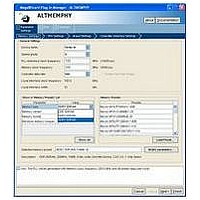IPR-HPMCII Altera, IPR-HPMCII Datasheet - Page 65

IPR-HPMCII
Manufacturer Part Number
IPR-HPMCII
Description
IP CORE Renewal Of IP-HPMCII
Manufacturer
Altera
Datasheet
1.IP-HPMCII.pdf
(176 pages)
Specifications of IPR-HPMCII
Software Application
IP CORE, Memory Controllers, SDRAM
Supported Families
Arria II GX, HardCopy III, Stratix III, Stratix IV
Core Architecture
FPGA
Core Sub-architecture
Arria, HardCopy, Stratix
Rohs Compliant
NA
Lead Free Status / RoHS Status
na
- Current page: 65 of 176
- Download datasheet (4Mb)
Chapter 5: Functional Description—ALTMEMPHY
Block Description
December 2010 Altera Corporation
Clock and Reset Management
1
Stratix III and Stratix IV Devices
The address and command clock is one of the PLL dedicated clock outputs whose
phase can be adjusted to meet the setup and hold requirements of the memory clock.
The Stratix III address and command clock, ac_clk_1x, is half rate. The command and
address pins use the DDIO output circuitry to launch commands from either the
rising or falling edges of the clock. The chip select (mem_cs_n), clock enable (mem_cke),
and mem_odt pins are enabled on one memory clock cycle basis and can be launched
from either the rising or falling edge of the ac_clk_1x signal, while the address and
other command pins are enabled for two memory clock cycles and can also be
launched from either the rising or falling edge of ac_clk_1x signal. It is the
responsibility of the controller to maintain the relative timing of the signals.
The DDR3 SDRAM PHY generates a write latency output ctl_wlat that indicates the
number of ctl_clk cycles between the write command being issued, ctl_cs_n
asserted, and ctl_dqs_burst being asserted. This ctl_wlat signal is only valid when
calibration has been successfully completed by the ALTMEMPHY sequencer and does
not change at any point during normal user mode operation. The value on ctl_wlat
includes the effect of the following as determined during calibration:
■
■
■
■
■
The clocking and reset block is responsible for clock generation, reset management,
and phase shifting of clocks. It also has control of clock network types that route the
clocks, which is handled in the <variation_name>_alt_mem_phy_clk_reset module in
the <variation_name>_alt_mem_phy.v/.vhd file.
Clock Management
The clock management feature allows the ALTMEMPHY megafunction to work out
the optimum phase during calibration, and to track voltage and temperature variation
relies on phase shifting the clocks relative to each other.
Certain clocks require phase shifting during the ALTMEMPHY megafunction
operation.
You can implement clock management circuitry using PLLs and DLLs.
The ALTMEMPHY MegaWizard Plug-In Manager automatically generates an
ALTPLL megafunction instance. The ALTPLL megafunction generates the different
clock frequencies and relevant phases used within the ALTMEMPHY megafunction.
The available device families have different PLL capabilities. The minimum PHY
requirement is to have 16 phases of the highest frequency clock. The PLL uses With
No Compensation option to minimize jitter. Changing the PLL compensation to a
different operation mode may result in inaccurate timing results.
CAS write latency (CWL)
Additive latency
Datapath latencies and relative phases
Board and memory module layout
Address and command path latency and 1T register setting which is dynamically
set up to take into account any leveling effects
Section II. DDR3 SDRAM Controller with ALTMEMPHY IP User Guide
External Memory Interface Handbook Volume 3
5–13
Related parts for IPR-HPMCII
Image
Part Number
Description
Manufacturer
Datasheet
Request
R

Part Number:
Description:
IP NIOS II MEGACORE RENEW
Manufacturer:
Altera
Datasheet:

Part Number:
Description:
IP CORE Renewal Of IP-XAUIPCS
Manufacturer:
Altera
Datasheet:

Part Number:
Description:
IP CORE Renewal Of IP-10GETHERNET
Manufacturer:
Altera
Datasheet:

Part Number:
Description:
IP CORE Renewal Of IP-ASI
Manufacturer:
Altera
Datasheet:

Part Number:
Description:
IP CORE Renewal Of IP-CIC
Manufacturer:
Altera
Datasheet:

Part Number:
Description:
IP CORE Renewal Of IP-CRC
Manufacturer:
Altera
Datasheet:

Part Number:
Description:
IP CORE Renewal Of IP-ED8B10B
Manufacturer:
Altera
Datasheet:

Part Number:
Description:
CPLD, EP610 Family, ECMOS Process, 300 Gates, 16 Macro Cells, 16 Reg., 16 User I/Os, 5V Supply, 35 Speed Grade, 24DIP
Manufacturer:
Altera Corporation
Datasheet:

Part Number:
Description:
CPLD, EP610 Family, ECMOS Process, 300 Gates, 16 Macro Cells, 16 Reg., 16 User I/Os, 5V Supply, 15 Speed Grade, 24DIP
Manufacturer:
Altera Corporation
Datasheet:

Part Number:
Description:
Manufacturer:
Altera Corporation
Datasheet:










